El Ocaso Finca – Finally a Great Cup of Coffee
This is post number eight from the wonderful country of Colombia which Alison and I are touring with Canadian travel company Adventures Abroad along with a group of sixteen others. In the last post we left the city of Bogota and arrived in the town of Salento, centre of the coffee growing business in Colombia. After lunch we all hopped into open topped Jeeps and headed out on the rugged dirt roads of the area for a visit to El Ocaso Finca, one of the country’s premiere coffee farms. It offers a comprehensive tour that takes the visitor through every step of the coffee process from seedling to bean to something in a cup that has entranced mankind since it was first sipped in Yemen in the 15th century.
Now I have to be honest, when I saw that a visit to a coffee farm was on the itinerary my first reaction was “Oh, joy.” Growing up in a family with two Nova Scotian parents, tea was always the drink of the house, even from a very young age when we were allowed to drink something that might be called thé au lait. Coffee was verboten. Around age ten I was at a friend’s house and he asked me if I wanted a cup of coffee, which of course, I couldn’t resist. He then proceeded to turn on the hot water faucet and added a heap of what might have been Sanka into the semi-hot water and handed it to me. I never tried coffee again until I was in university. I’ve gone through various stages of a not quite love affair with coffee since then. Once in a blue moon I’ll come across a great cup of coffee, but usually it’s a waste of money. I guess that’s why this visit to El Ocaso wasn’t one of the main things I was looking forward to in Colombia. Come along and find out if my qualms are legit or overblown.
El Ocaso Finca
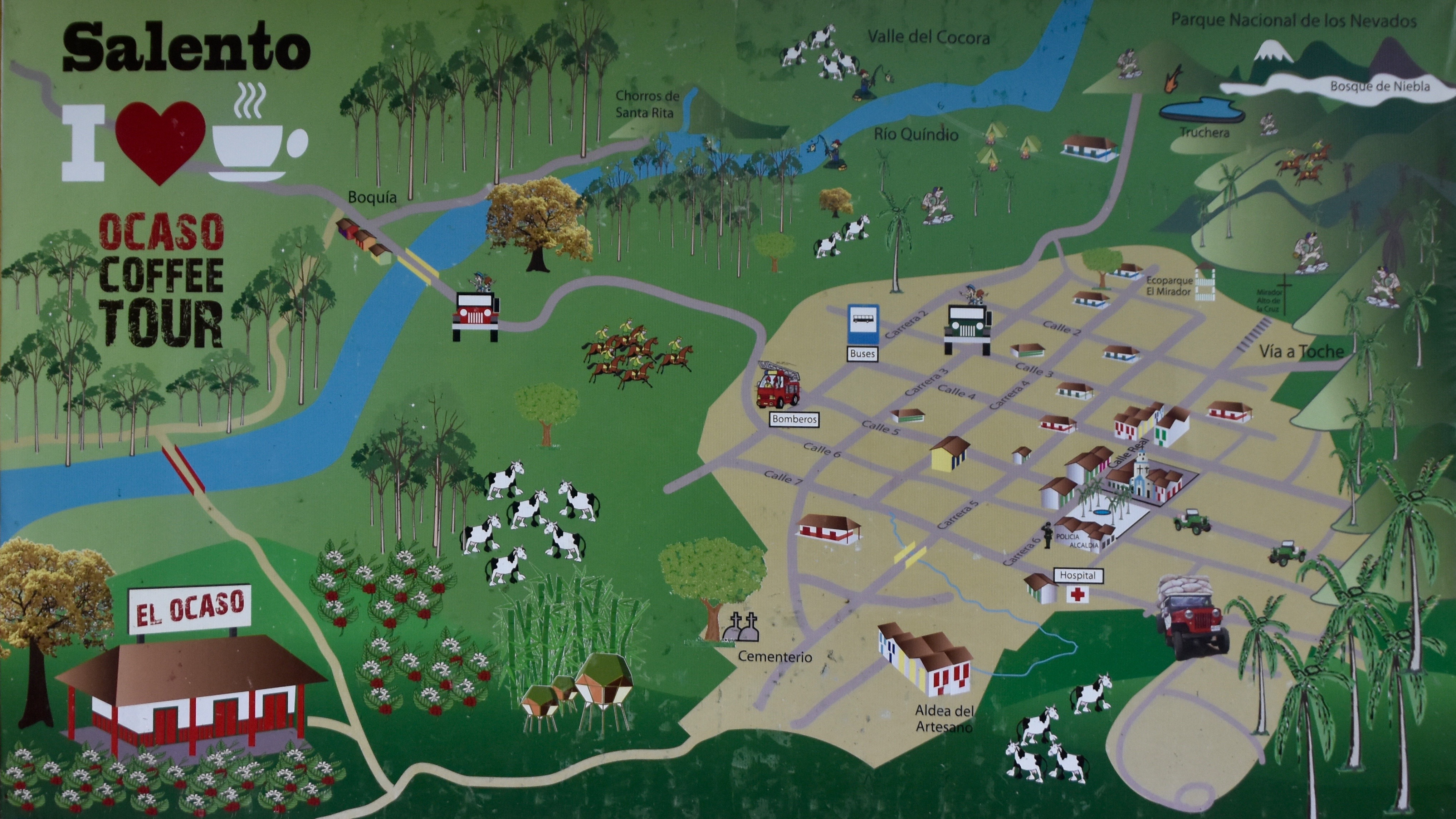
El Ocaso is not as close to Salento as this map would make you think. It’s 5 km. (3 miles) from Salento Plaza, but the road is very bumpy and at times you might feel like you’ve been transported into an episode of Rat Patrol, but it’s great fun nevertheless. We passed numerous groups of hikers and horseback riders along the way.
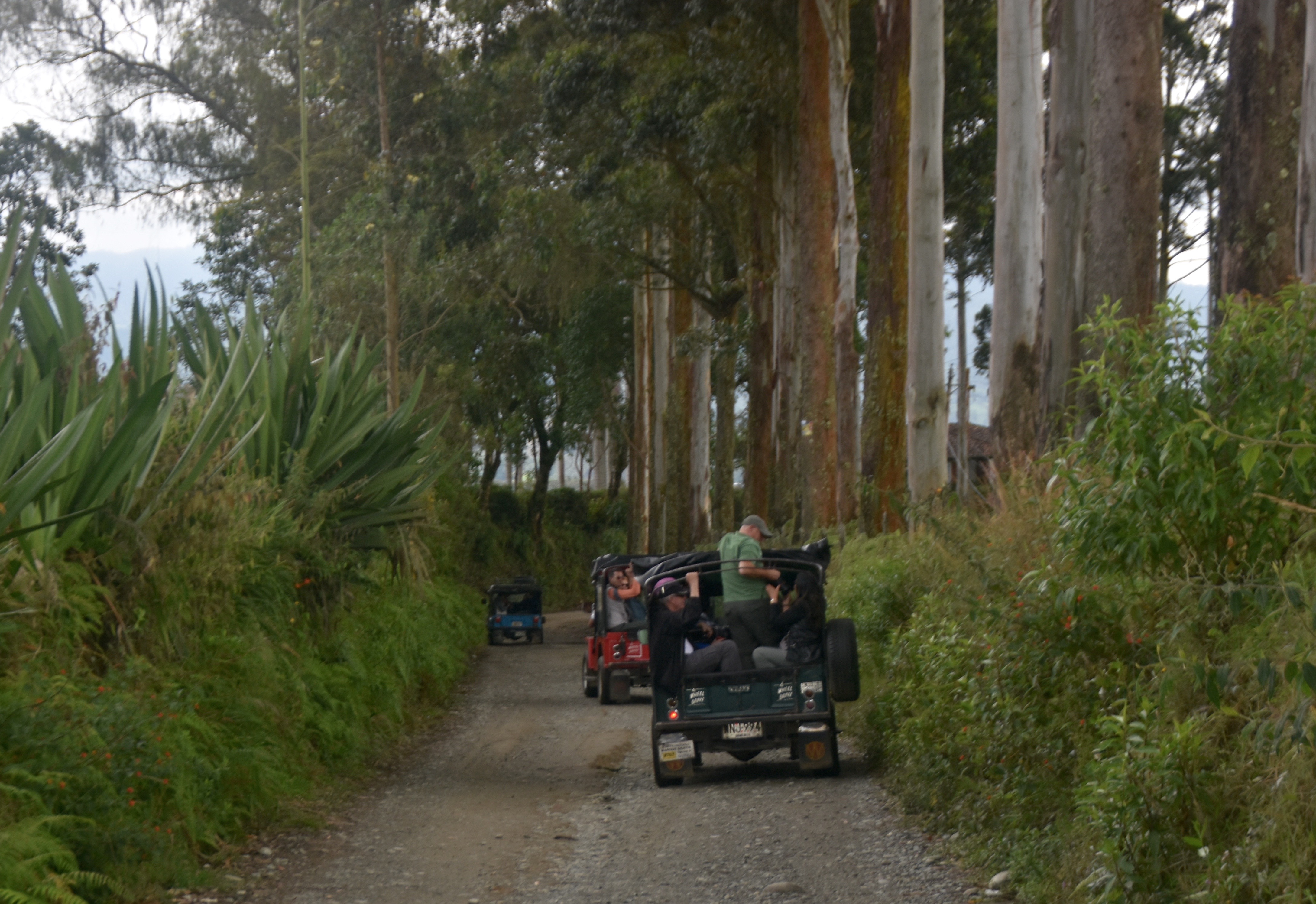
The main building that houses El Ocaso is very much in the gayly decorated wood style of most of Salento’s buildings – very photogenic. It sits on the edge of a valley amidst a sea of dozens of shades of green interspersed with flowering shrubs, orchids and hanging baskets.
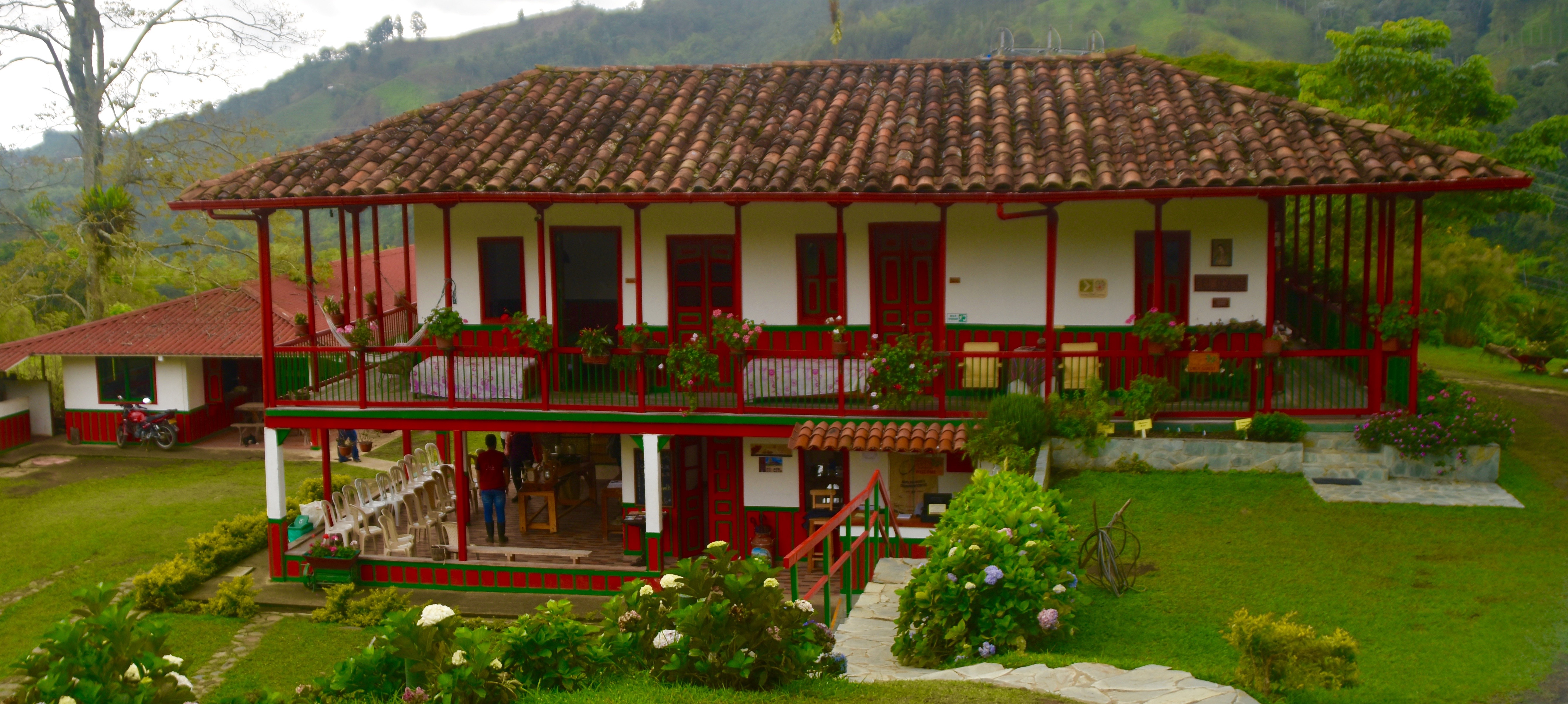
The tour itself is comprised of two distinct parts. One takes place inside the ‘coffee lab’ where our noses and taste buds will be given a lesson in distinguishing the various aromas and flavours that one might find in a good or terrible cup of coffee. The other takes place in the field where the life cycle of the coffee plant will be examined from seedling to dried bean ready for roasting. We are split into two groups of eight and ours is headed for the lab.
Once inside, we are all handed a sheet of paper upon which we will be tested. This is our instructor Daniel who explains the process. Alison looks sceptical.
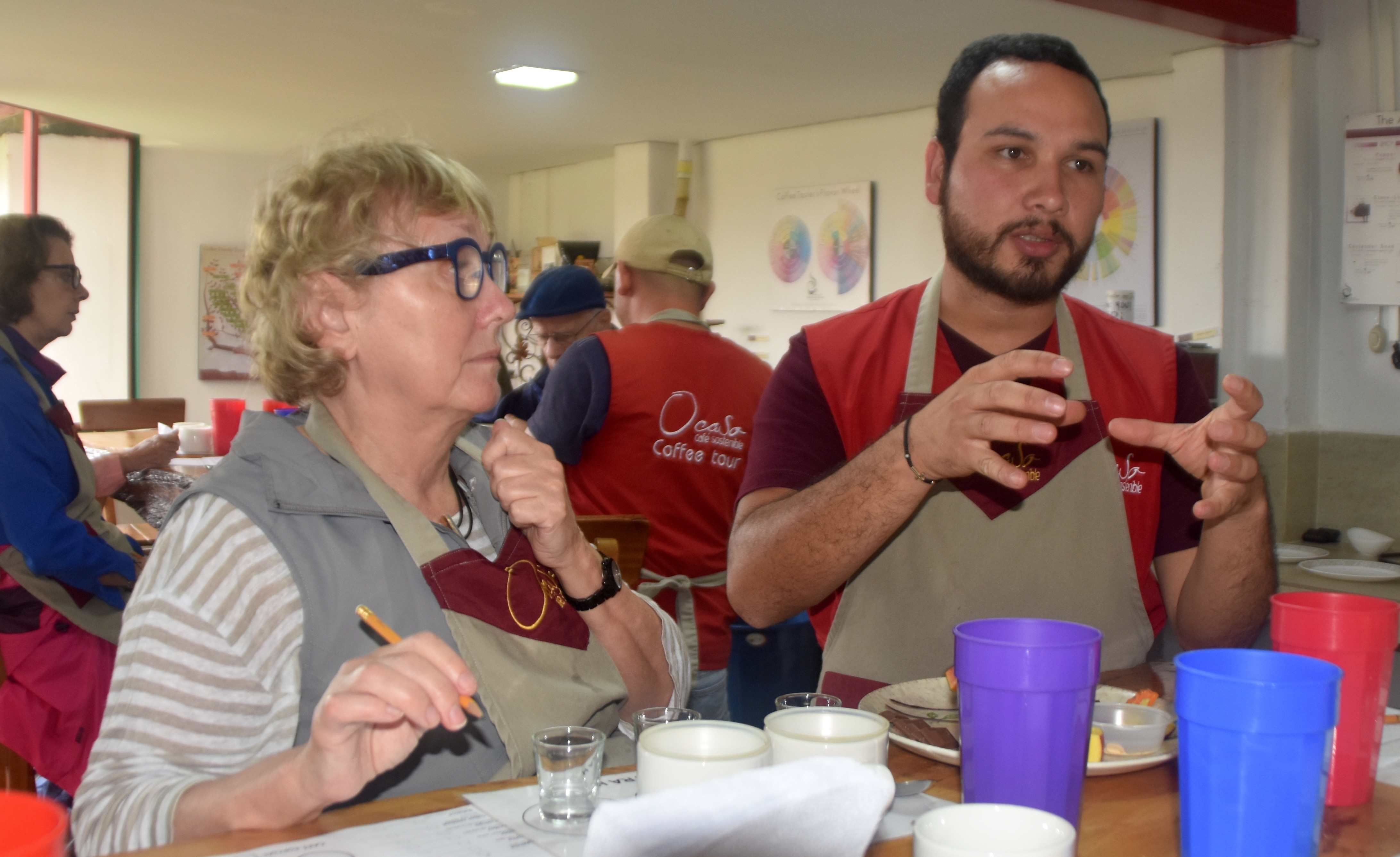
We are also given a series of glasses for reasons not readily apparent. This is getting downright serious.
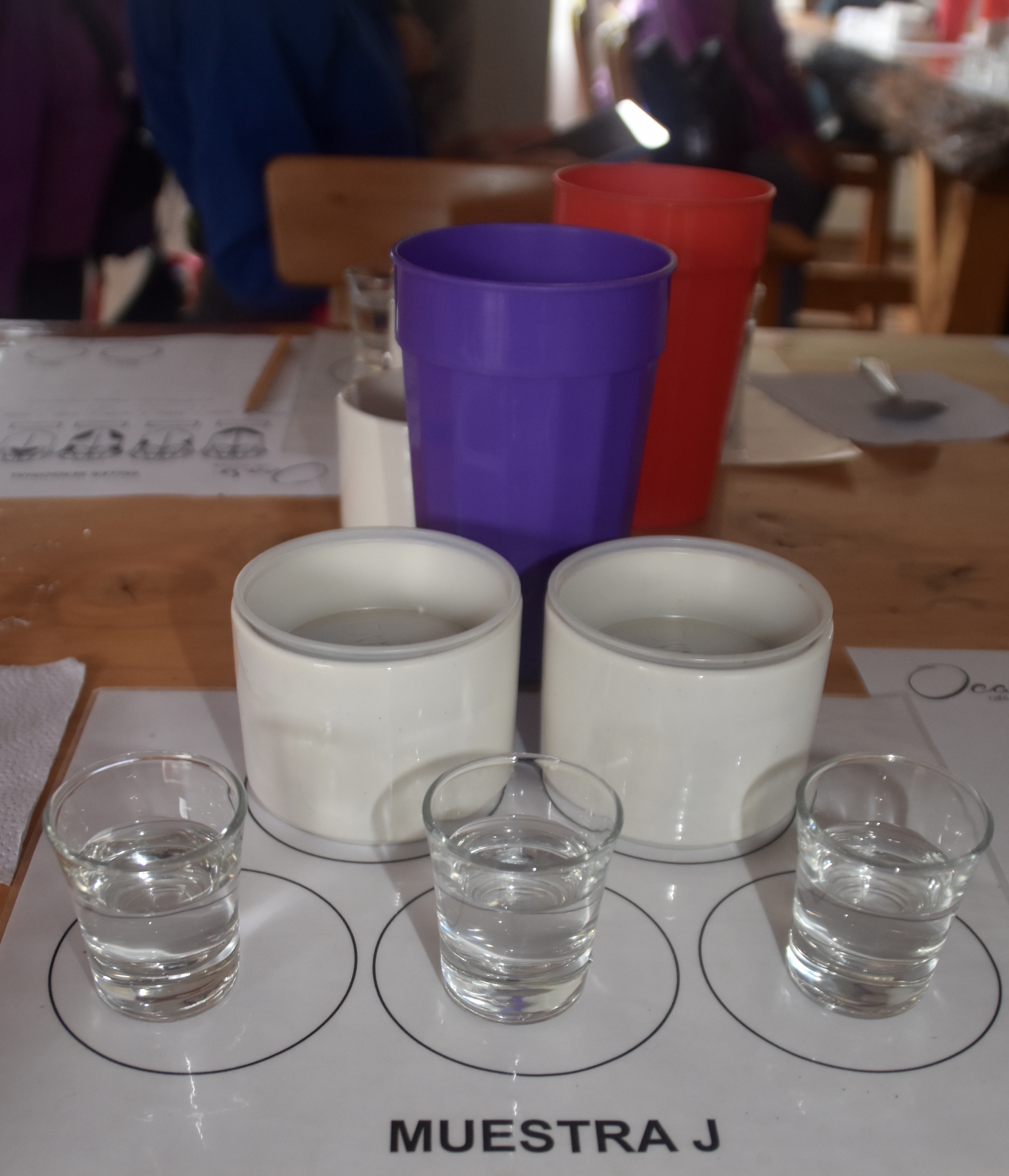
To make a long story short, we first sniff six unknown substances to identify their predominant aroma. Then we taste five items to describe their textures. And lastly we compare two cups of hot water that have two different grinds of coffee added to them to see if we have a clue which is actually good and which is crap.
Here is my test paper complete with appropriate coffee stain.
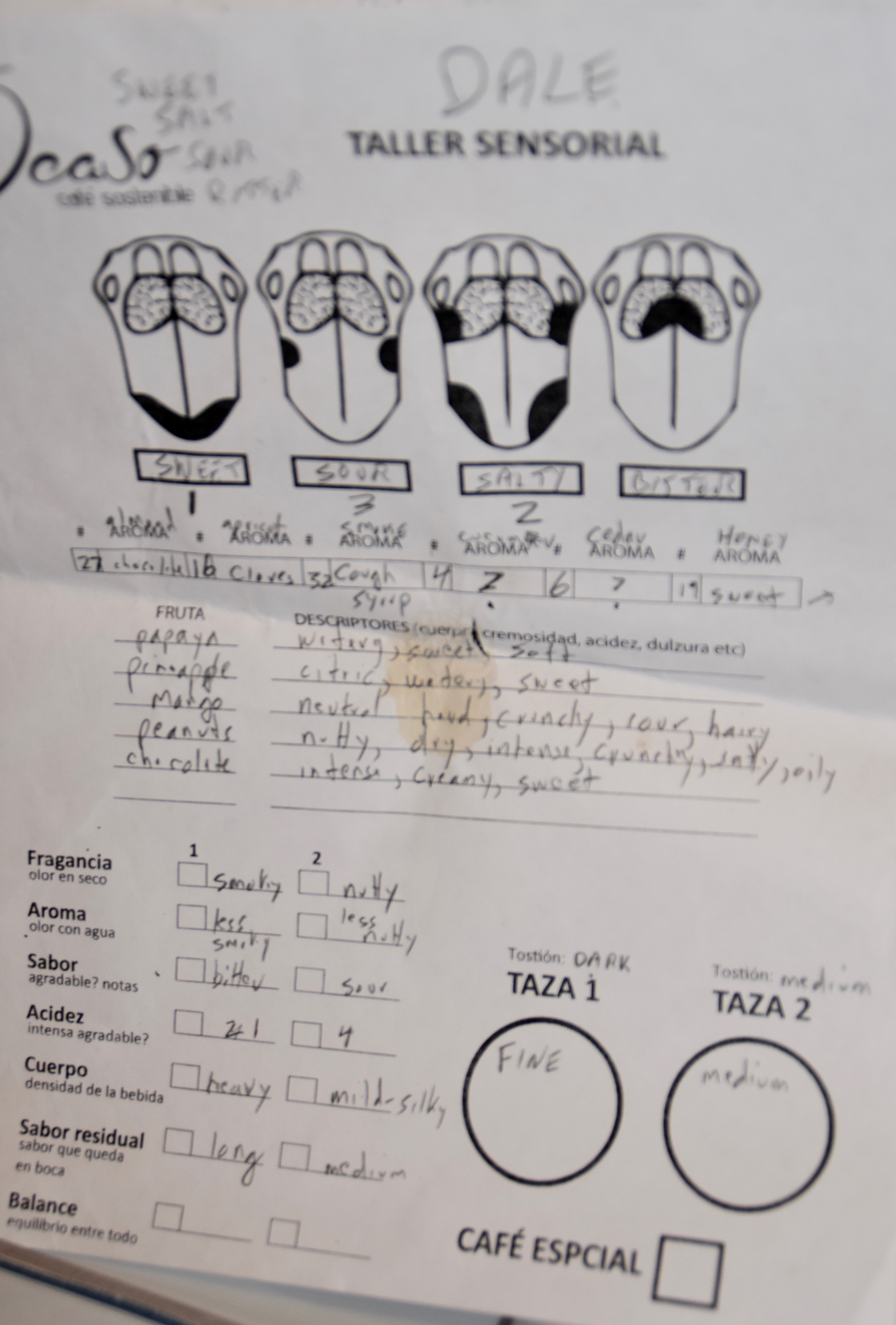
On the sniff test I thought almond was chocolate, apricot was cloves, smoke was cough syrup (Doh!), had no clue on cucumber or cedar and got a half point for identifying honey as something sweet. On the taste test, I nailed peanuts by describing them as ‘nutty’ – not so great on papaya, pineapple, mango and chocolate. Finally, on the good coffee vs. bad coffee, I actually did figure out that the medium grind was lighter tasting and less bitter than the fine grind. The bottom line is that I won’t be hiring on as a coffee taster anytime soon.
Despite abjectly flunking the test, Daniel wished me well on the rest of the tour.
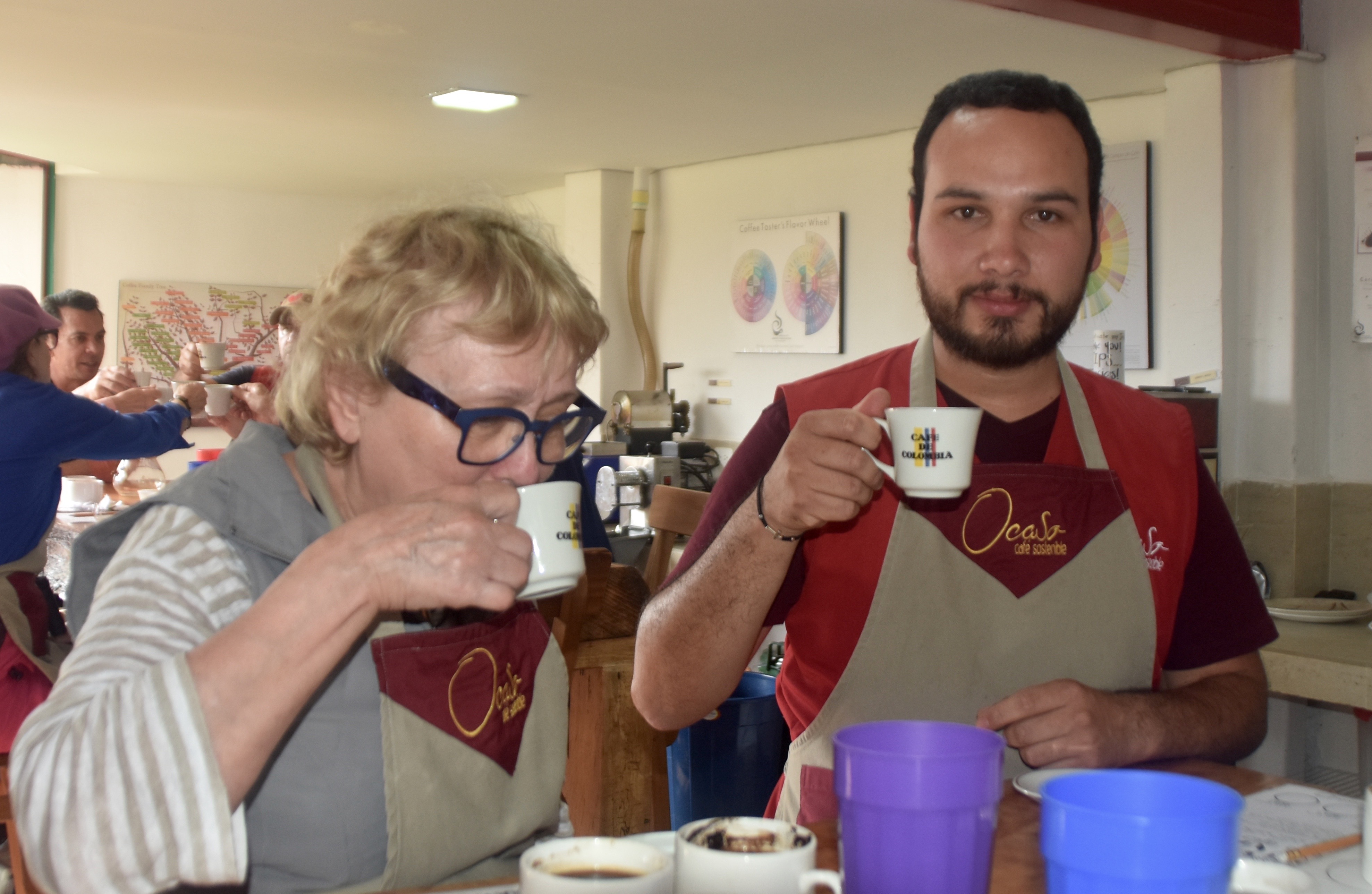
From here we headed outside where Jorge took over, starting with an explanation of how the tiny seeds are first planted in a sand medium and grow into seedlings.
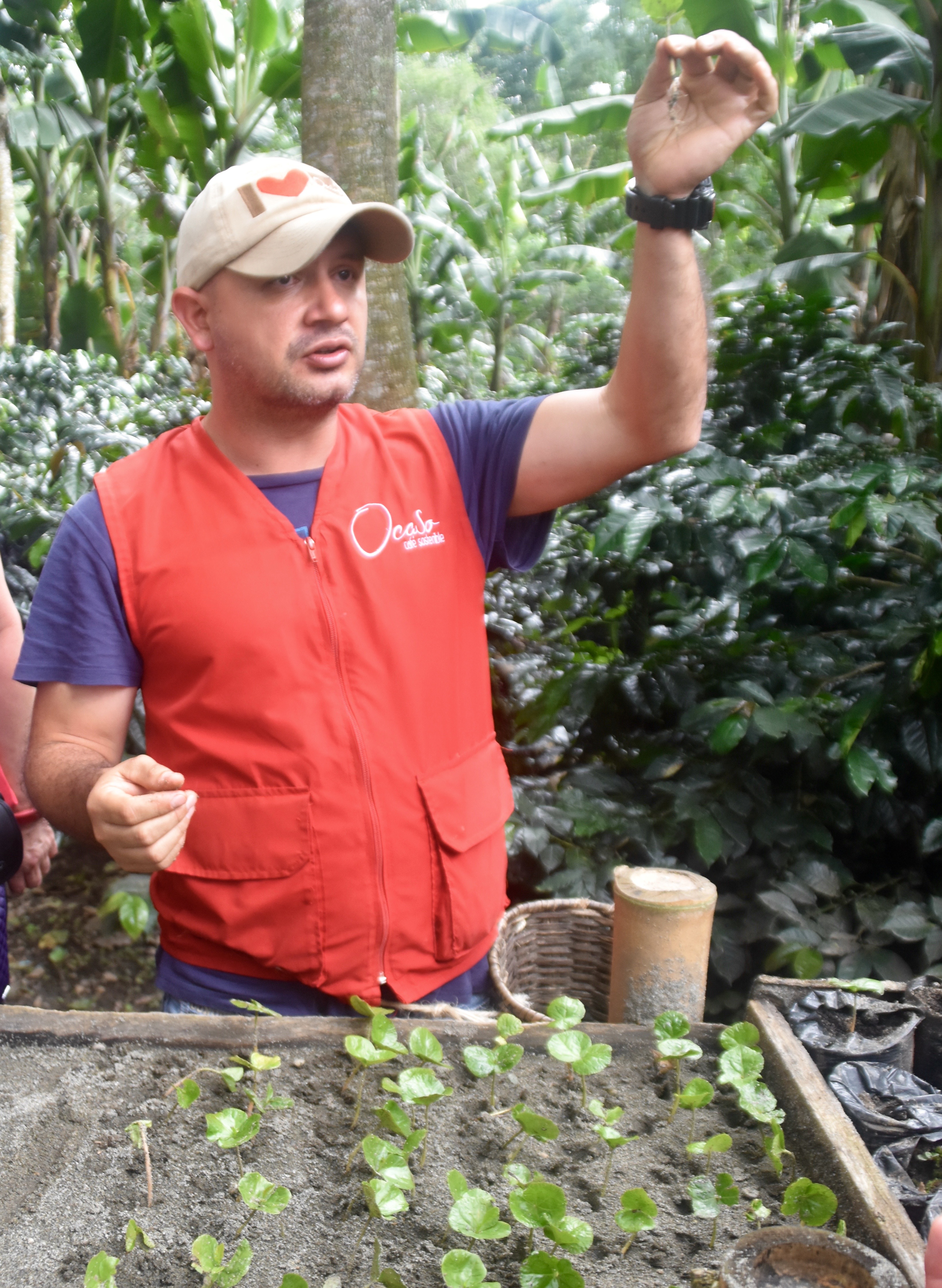
Here’s Alison planting her very own coffee. Now all she needs to do is come back in three years and transplant it into the coffee fields.
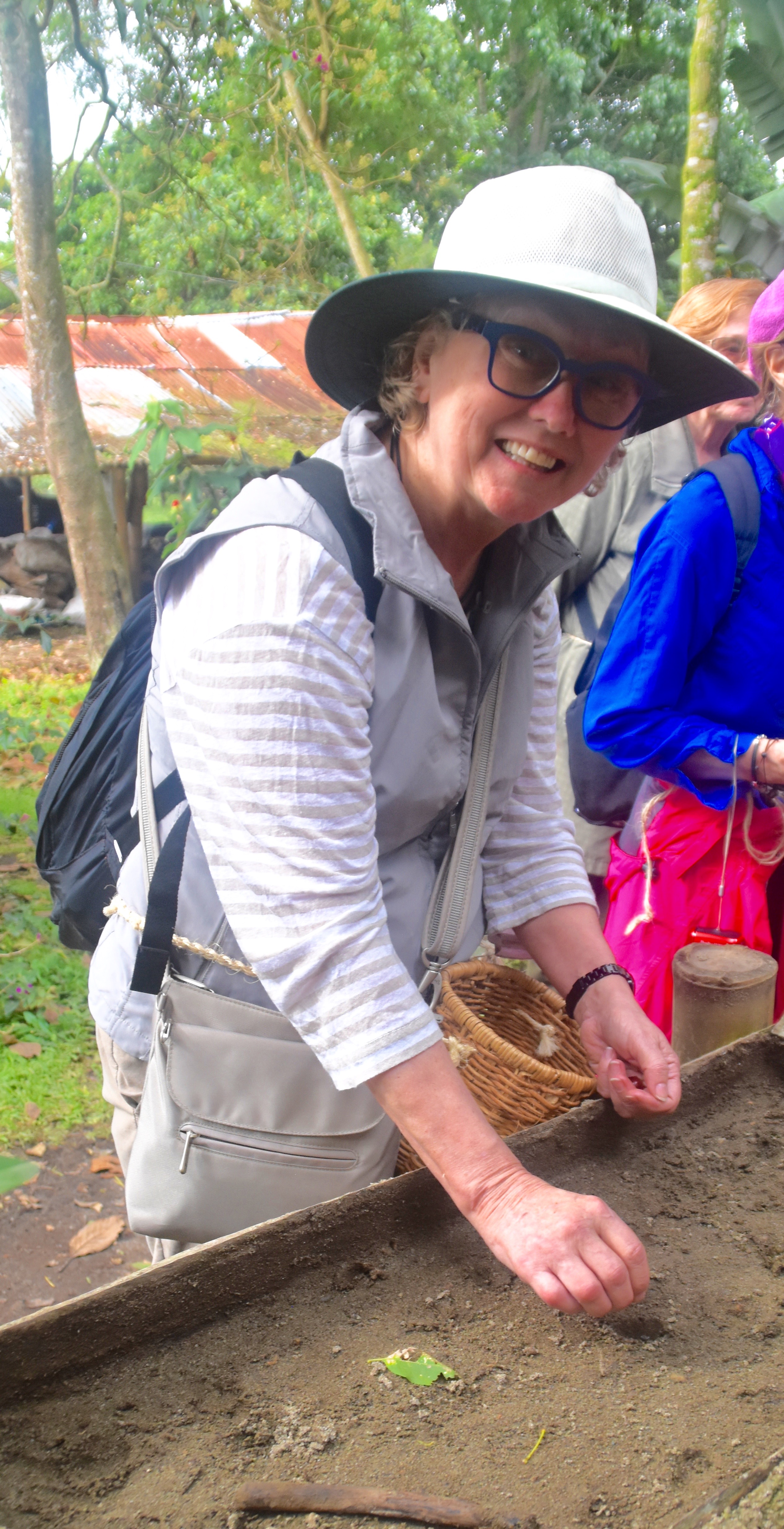
Then Jorge gives us a lesson in coffee beans. It turns out that what most of us traditionally think of as a coffee been is not. The beans are actually slimy little things encased in the more familiar berry that is picked when it turns red. If you squeeze a ripe coffee berry hopefully this is what you get, besides sticky fingers. I say hopefully because there can be anywhere from one to three beans in each fruit so the more you get, the better the yield.
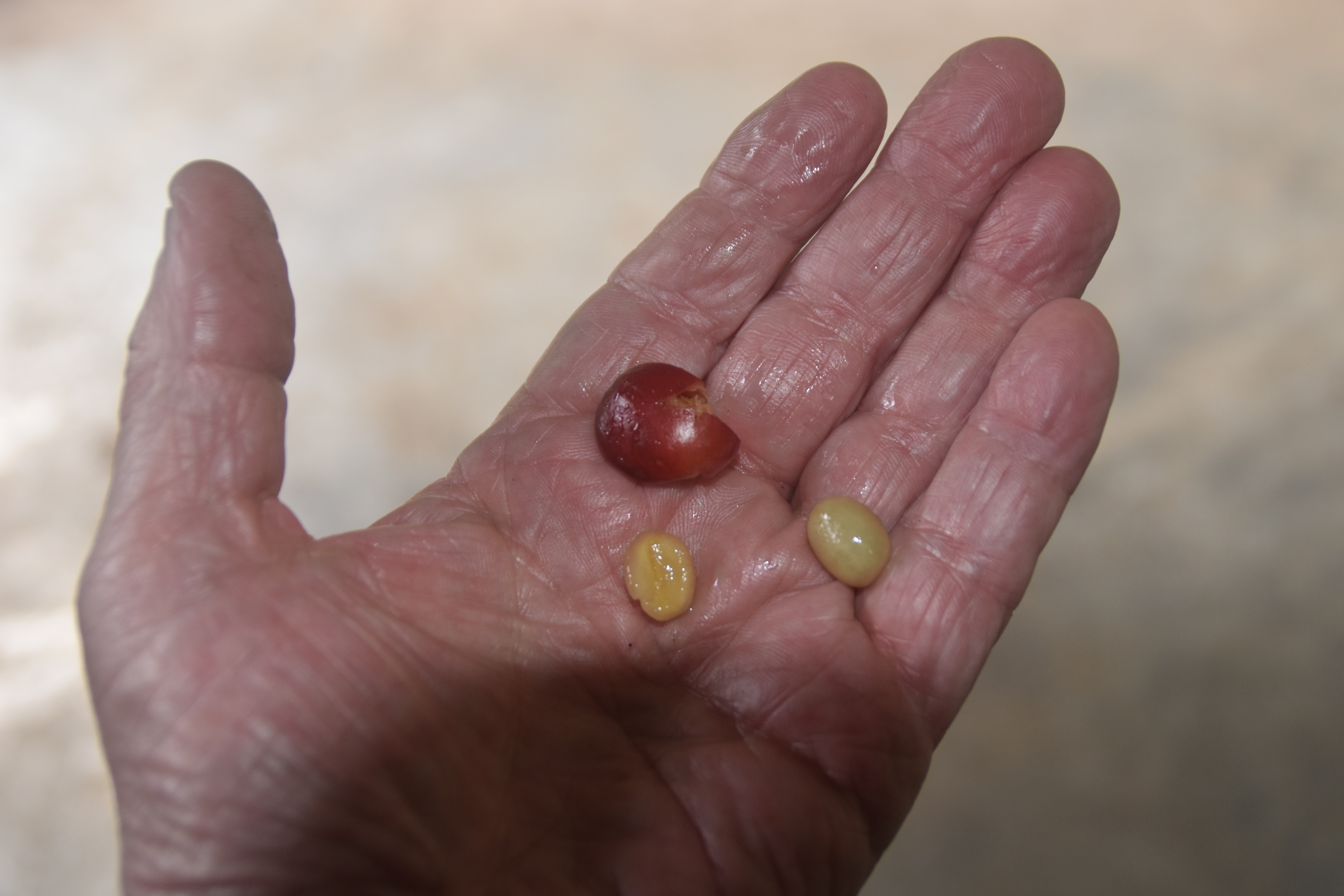
Ok, it’s time to enter the coffee fields.
I mentioned in the previous post and illustrated with the pictures from the Salento mirador, what a beautiful countryside this coffee growing culture produces. The land is by no means turned into an agricultural mono-crop wasteland. In fact, the coffee is grown in tandem with a variety of other wild and domesticated plants in such a unique manner that UNESCO has recognized the resultant landscape with a World Heritage Designation. Here’s how it is described on the official UNESCO site.
Coffee Cultural Landscape of Colombia
An exceptional example of a sustainable and productive cultural landscape that is unique and representative of a tradition that is a strong symbol for coffee growing areas worldwide – encompasses six farming landscapes, which include 18 urban centres on the foothills of the western and central ranges of the Cordillera de los Andes in the west of the country. It reflects a centennial tradition of coffee growing in small plots in the high forest and the way farmers have adapted cultivation to difficult mountain conditions. The urban areas, mainly situated on the relatively flat tops of hills above sloping coffee fields, are characterized by the architecture of the Antioquian colonization with Spanish influence. Building materials were, and remain in some areas, cob and pleated cane for the walls with clay tiles for the roofs.
Now Jorge leads us up into the coffee fields. You’ll notice that there are substantial trees which shade the coffee plants as well as grow fruits such as mangoes, papaya and banana.
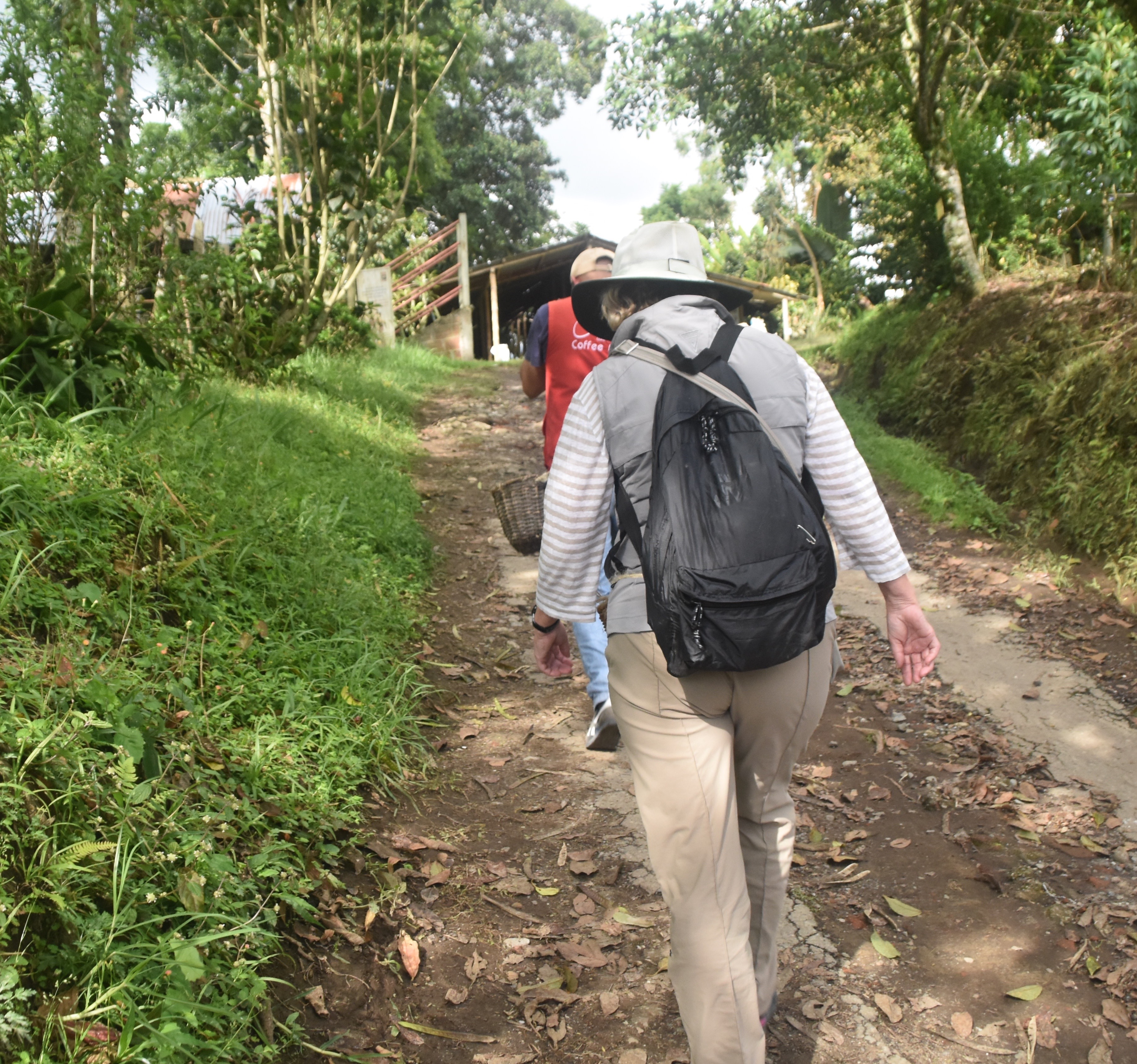
Here is a mature arabica coffee plant covered with unripe fruit, although if you look closely you can see some of them just starting to turn red.
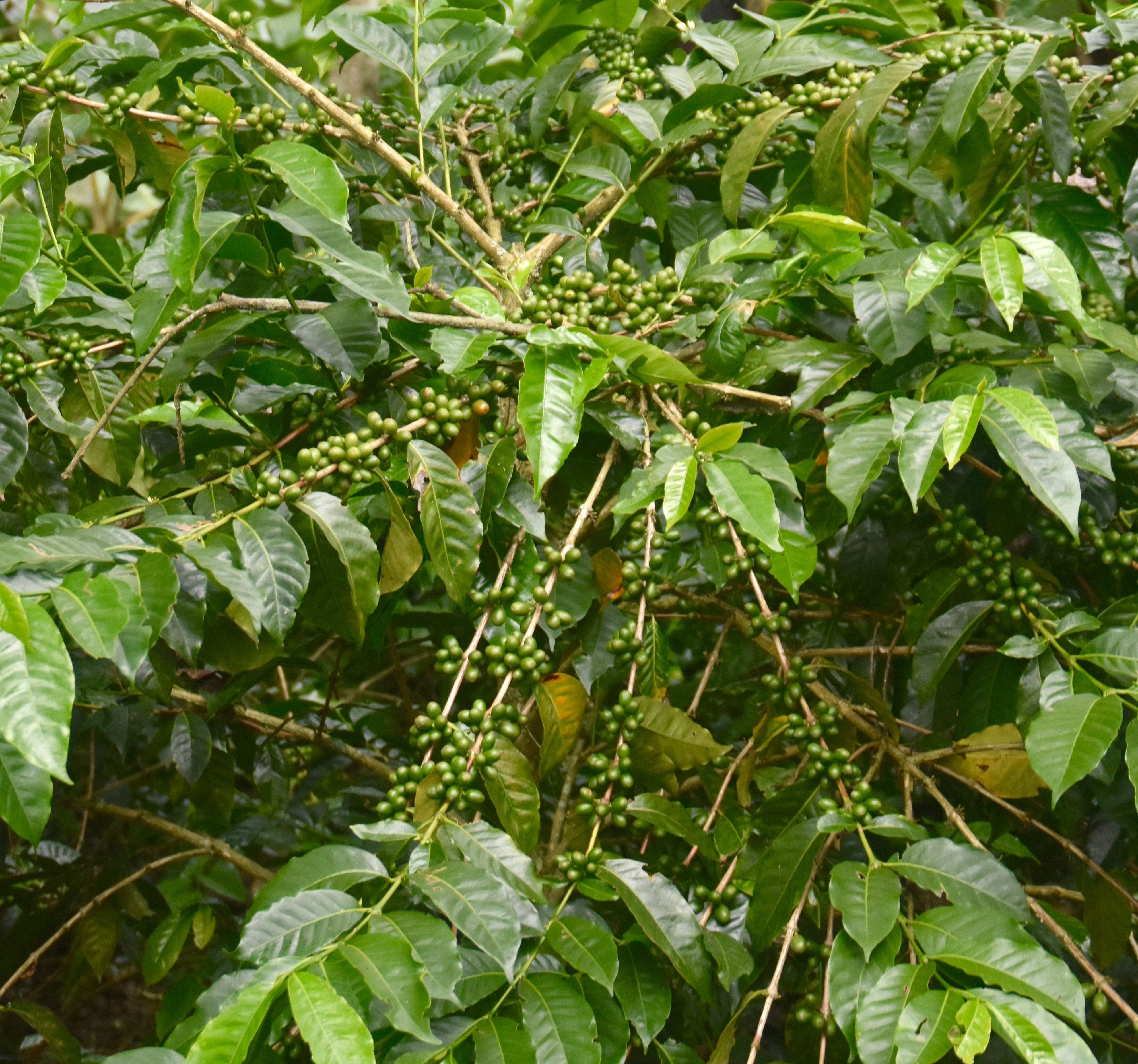
We have all been outfitted with traditional woven baskets and Jorge gives us five minutes to see how many ripe berries we can pick in that time.
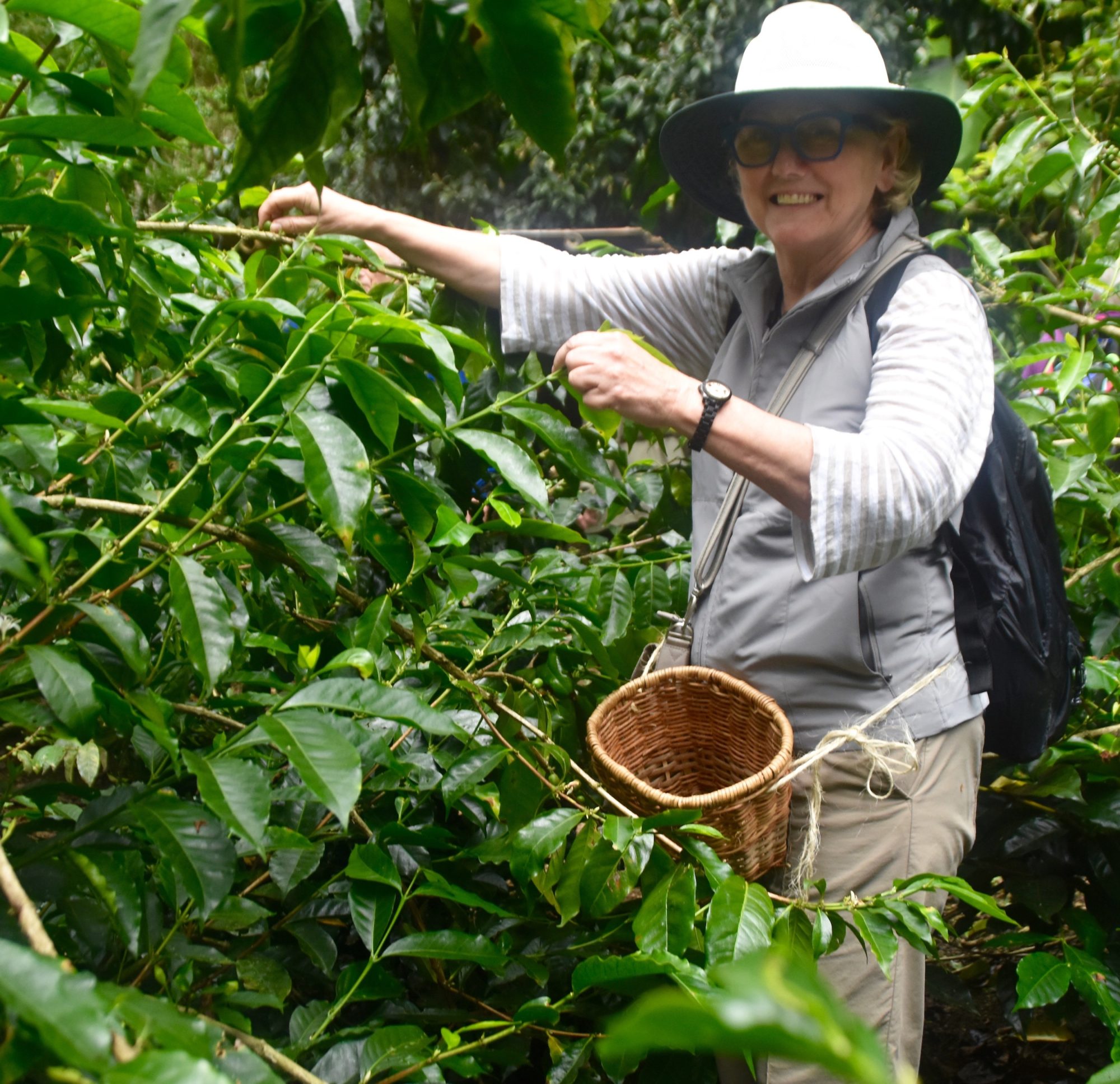
I’m thinking, “It’s the old Tom Sawyer trick. Get somebody else to do the work for you and make them think it’s a privilege.” However, after five minutes of fruitlessly thrashing around I realize El Ocaso would be out of business in no time if they actually relied on the tourists to do the work. In a word, our take is pathetic.
This picture is out of focus because I was laughing so much at our inane efforts. Believe it not, this was the most berries anyone picked.
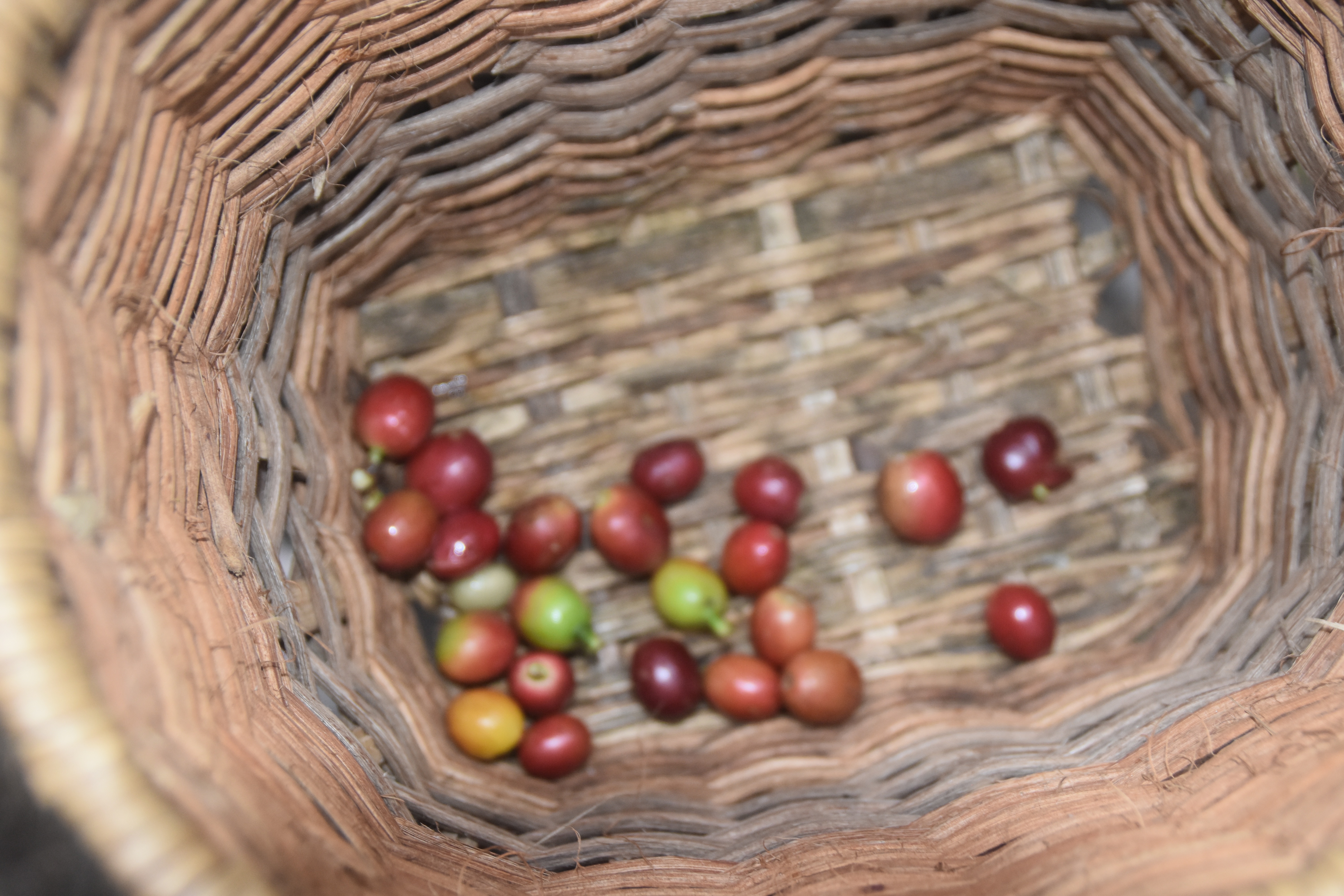
It was time now to return to base camp and start the processing of the beans, on the way passing numerous Heliconia or Lobster Claw plants along the way. While El Ocaso does use some more modern processing techniques, Jorge was demonstrating for us the traditional methods that have been in use for almost two hundred years.
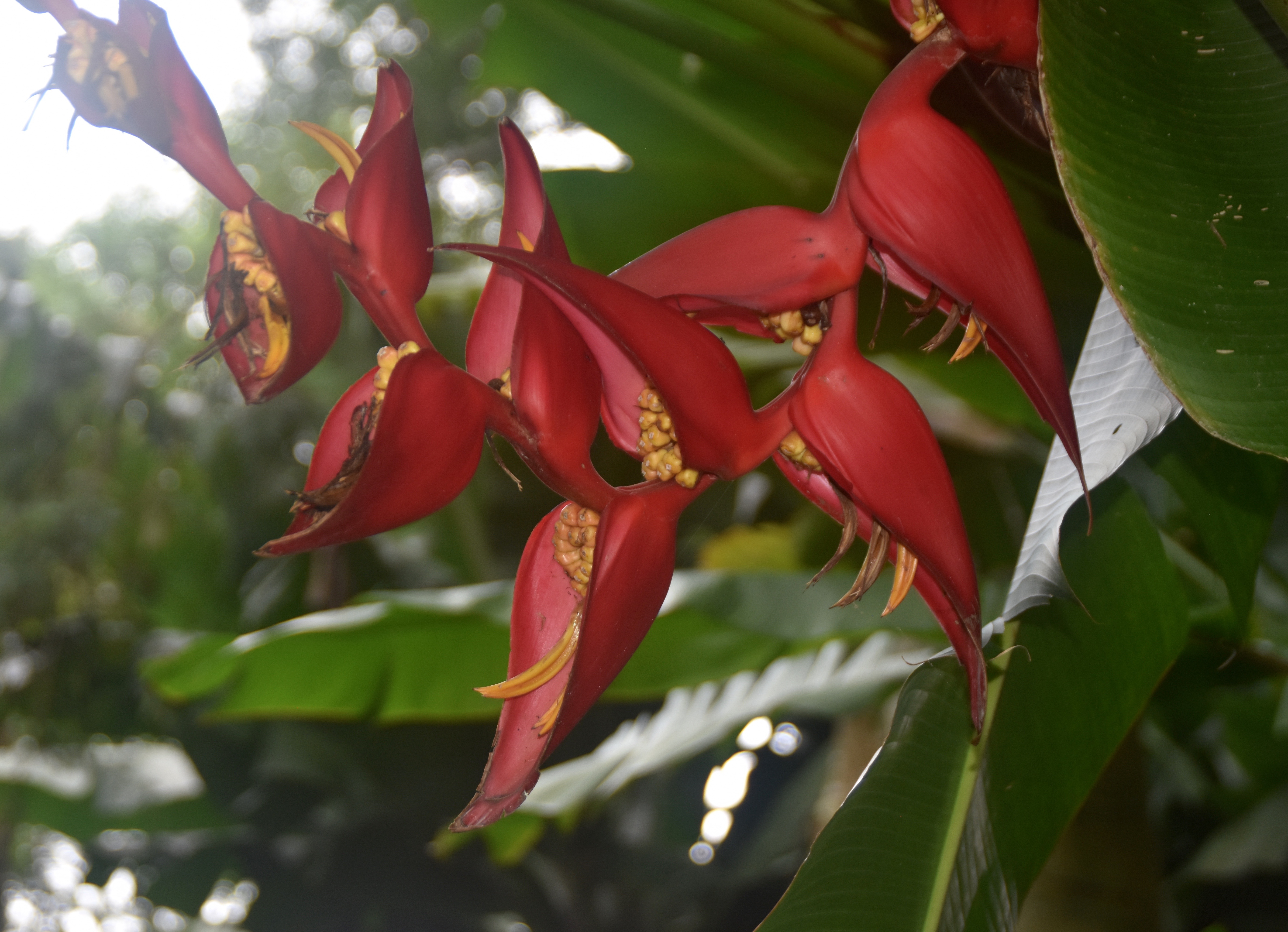
The first step is to put the berries in this machine which looks like, but is not a coffee grinder. It is a machine used to separate the beans from the berries and believe me, turning that handle requires strength.
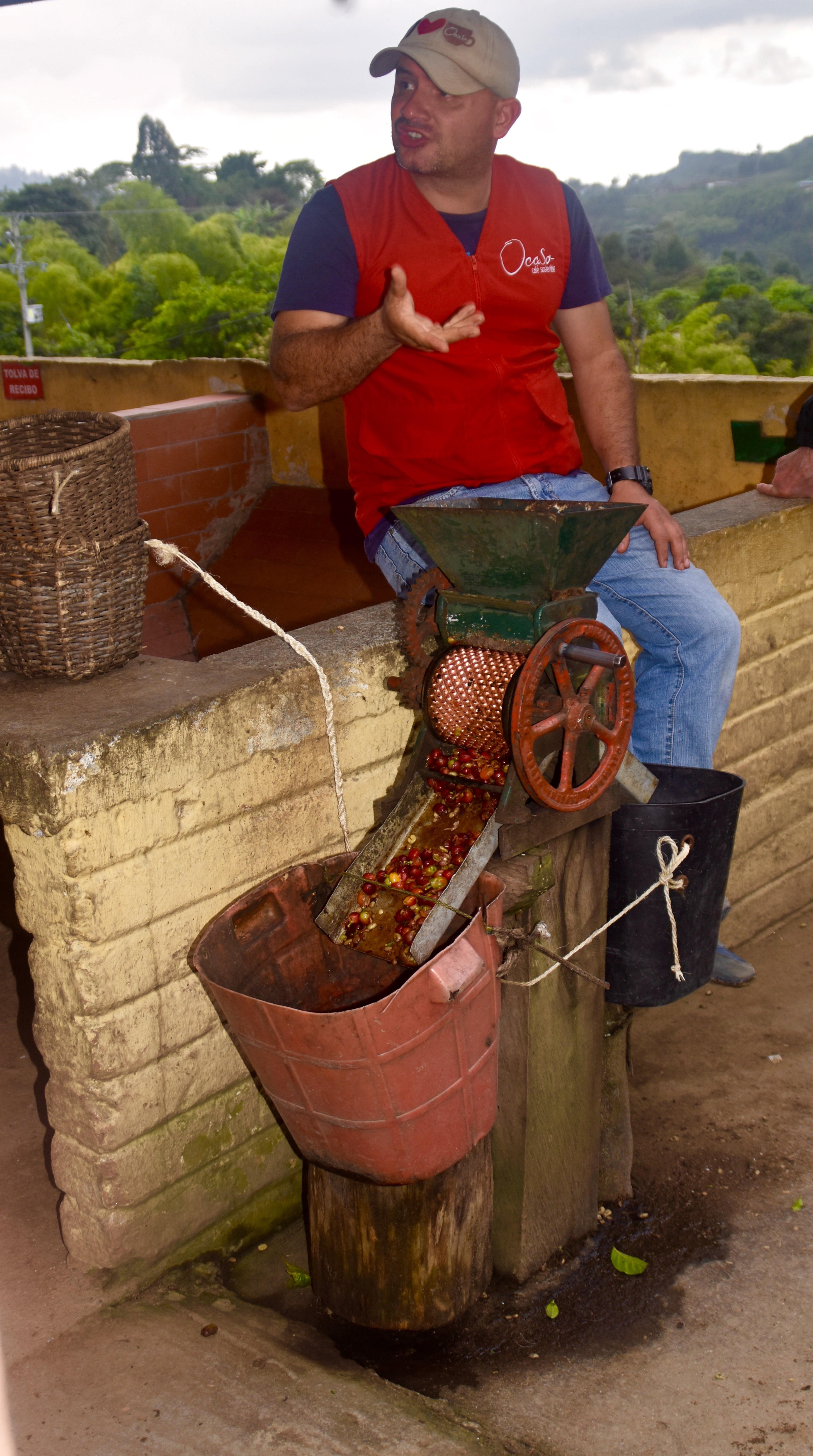
So now that we have a tiny pile of slimy beans the next step is the drying. These days it is done with the help of gas fired dryers, but the traditional method is using good old fashioned hot weather. This is the almost finished product.
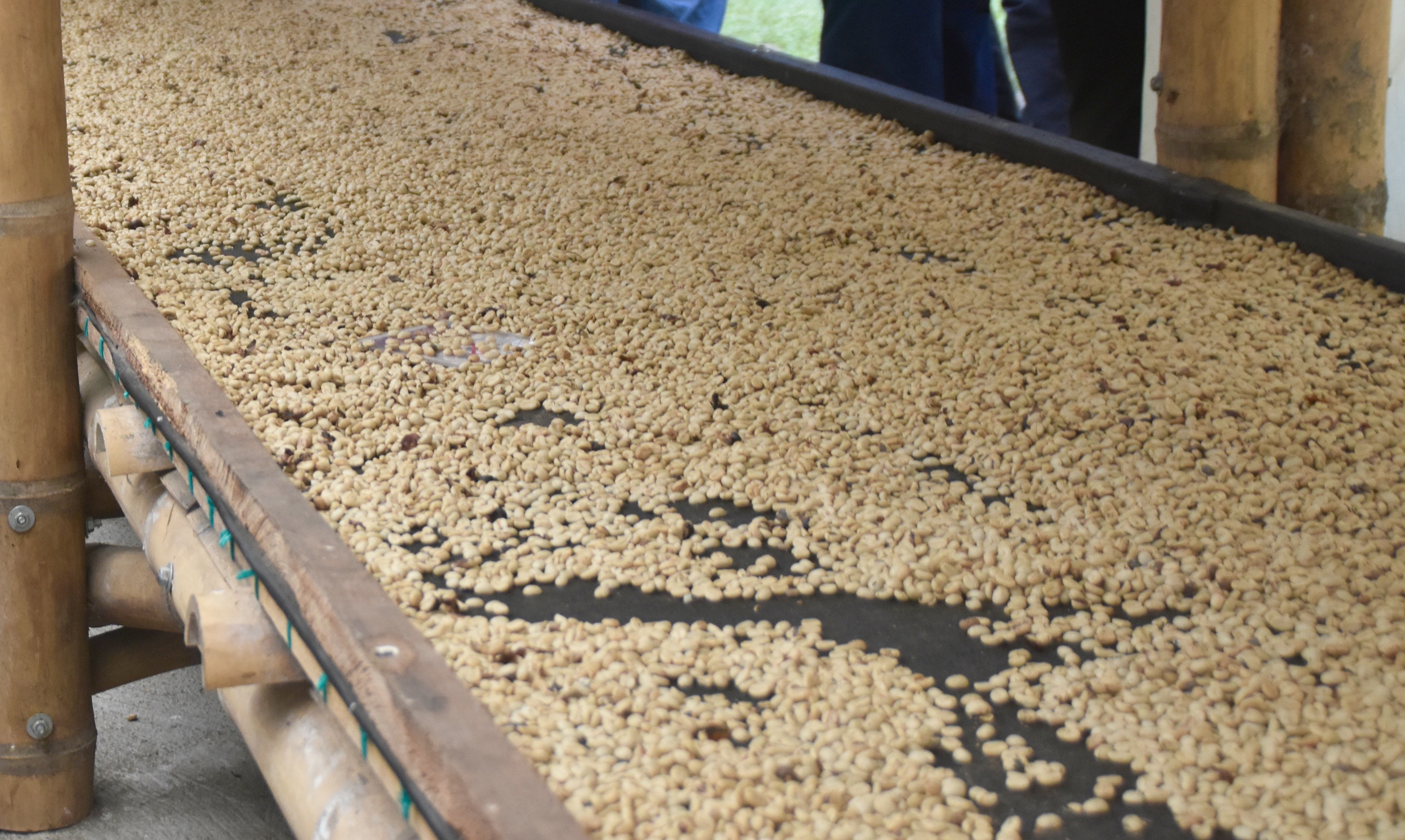
The beans still have a husk on them that needs to be removed which at one time was done by hand. At the same time the beans are separated for quality.
Here is the final result. On the left are the bean husks that have been removed and can now be recycled as either compost or fuel for the dryers. In the middle is almendra, which literally translates as ‘coffee beans’. This is what El Ocaso and every other coffee farm in Colombia actually ships to North America. These are the beans that will be roasted in Canada and the U.S. to produce what we buy on our grocery shelves or specialty stores.
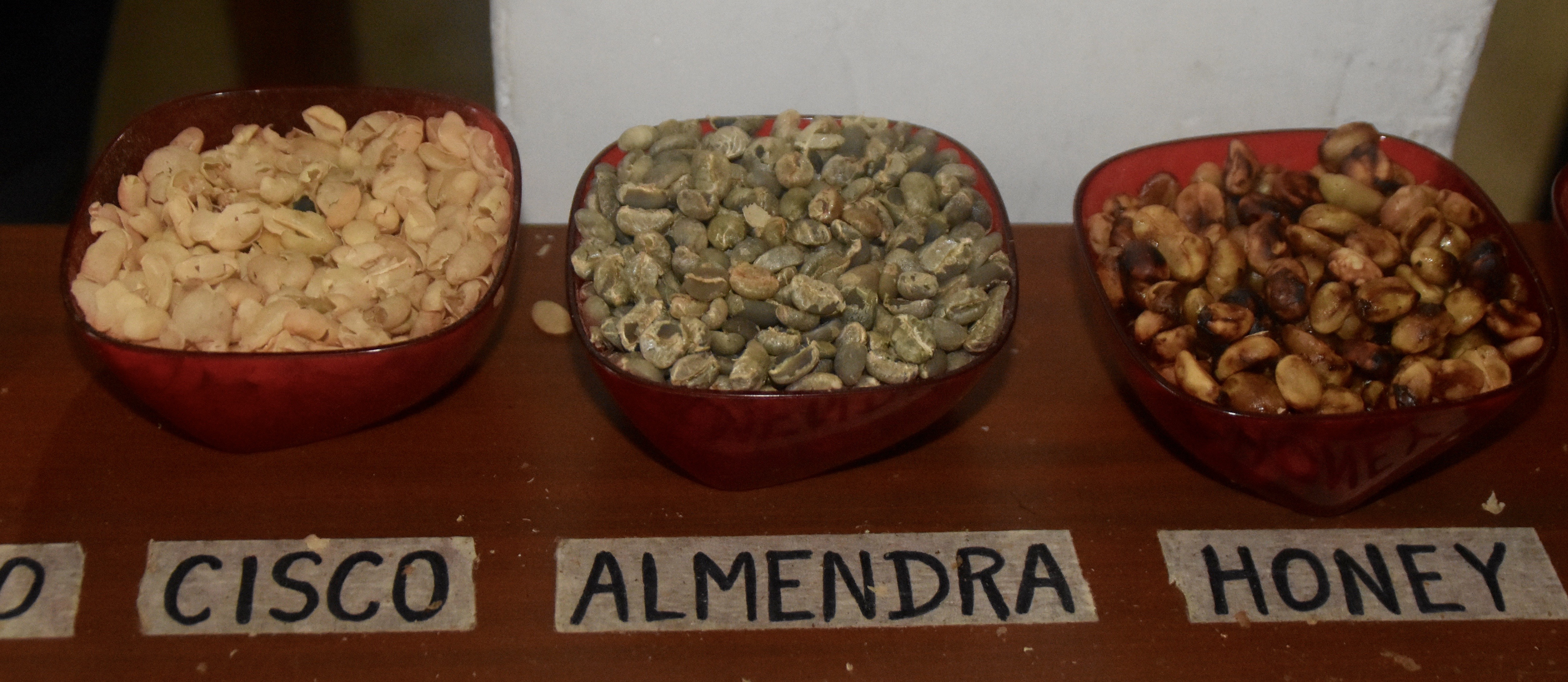
What about the beans on the right, labelled honey? These are made by a slightly different process that allows some of that sticky mucilage that’s inside the berry to remain throughout the drying process. I’d never heard of this before and apparently honey beans require a lot more work and thus are more expensive.
We are finally at the end of the class and sit down to sample coffee that has been grown and roasted at El Ocaso. Jorge explains the various types of machines that are used throughout the world to produce the brew with a thousand nicknames. The coffee we try this afternoon is made through a simple filtering process, but the hot water is poured very slowly.
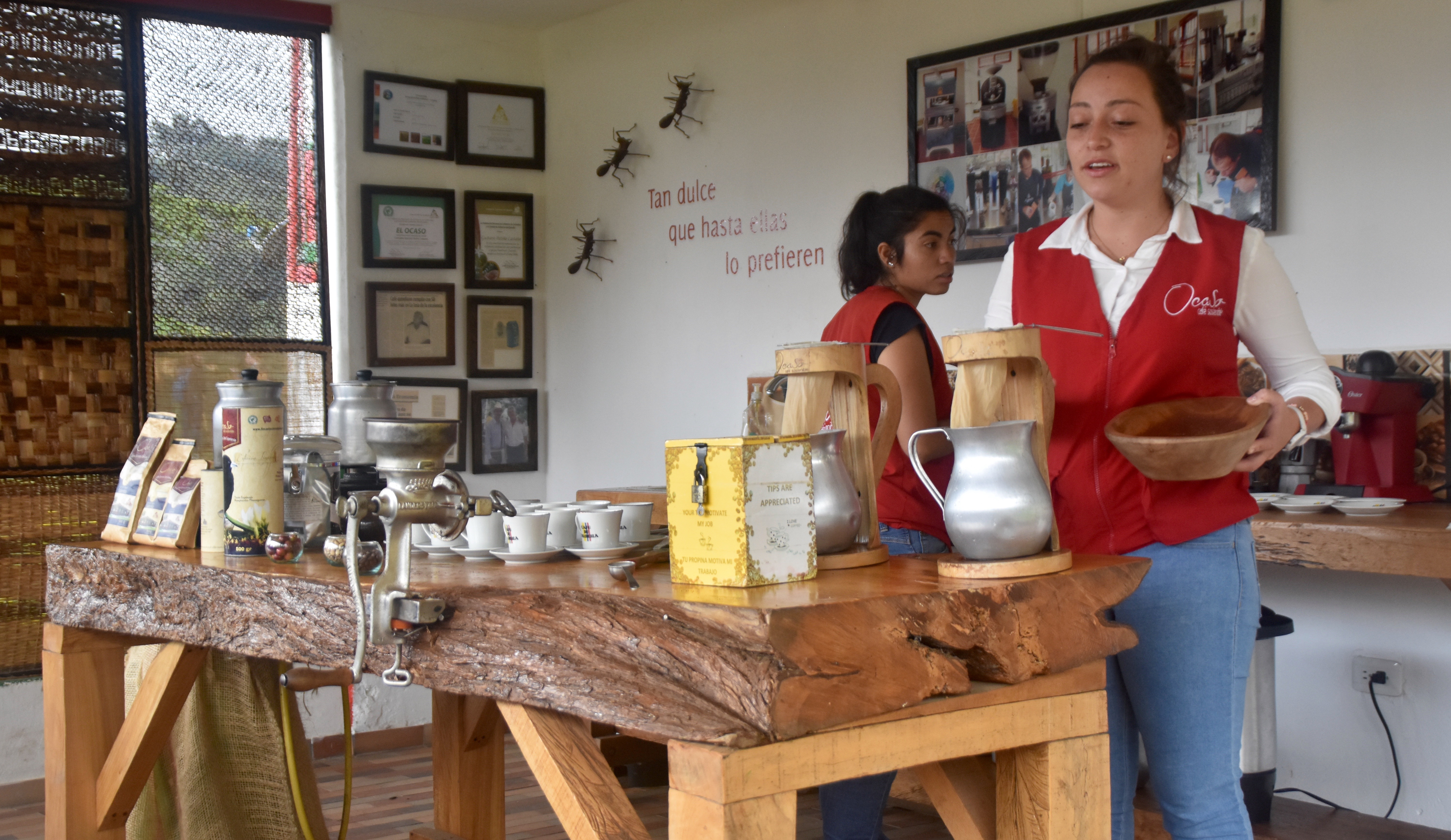
At the end of the three hour tour, we get to taste what I think is the best cup of coffee I’ve ever had – not too strong or weak, not too bitter or acidic. In other words, the Goldilocks of coffee. Alison agrees.
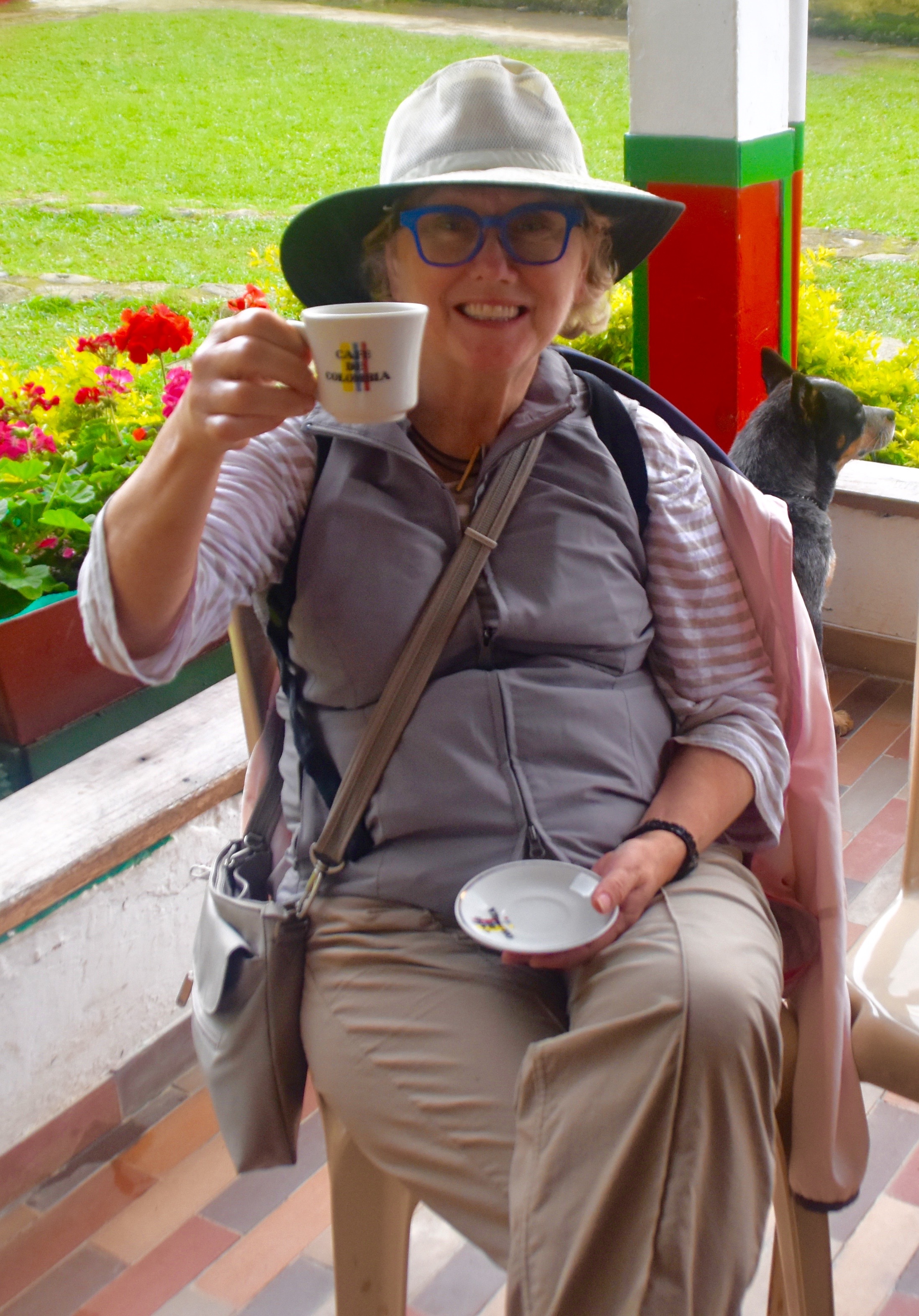
For forty years I’ve been adding milk to my coffee and now realize that with truly good coffee this is nothing short of desecration. I’ll never do it again, unless it’s a latte.
Despite my dismal performance in the smelling, tasting and picking departments I am still awarded this nicely calligraphed certificate, suitable for framing.
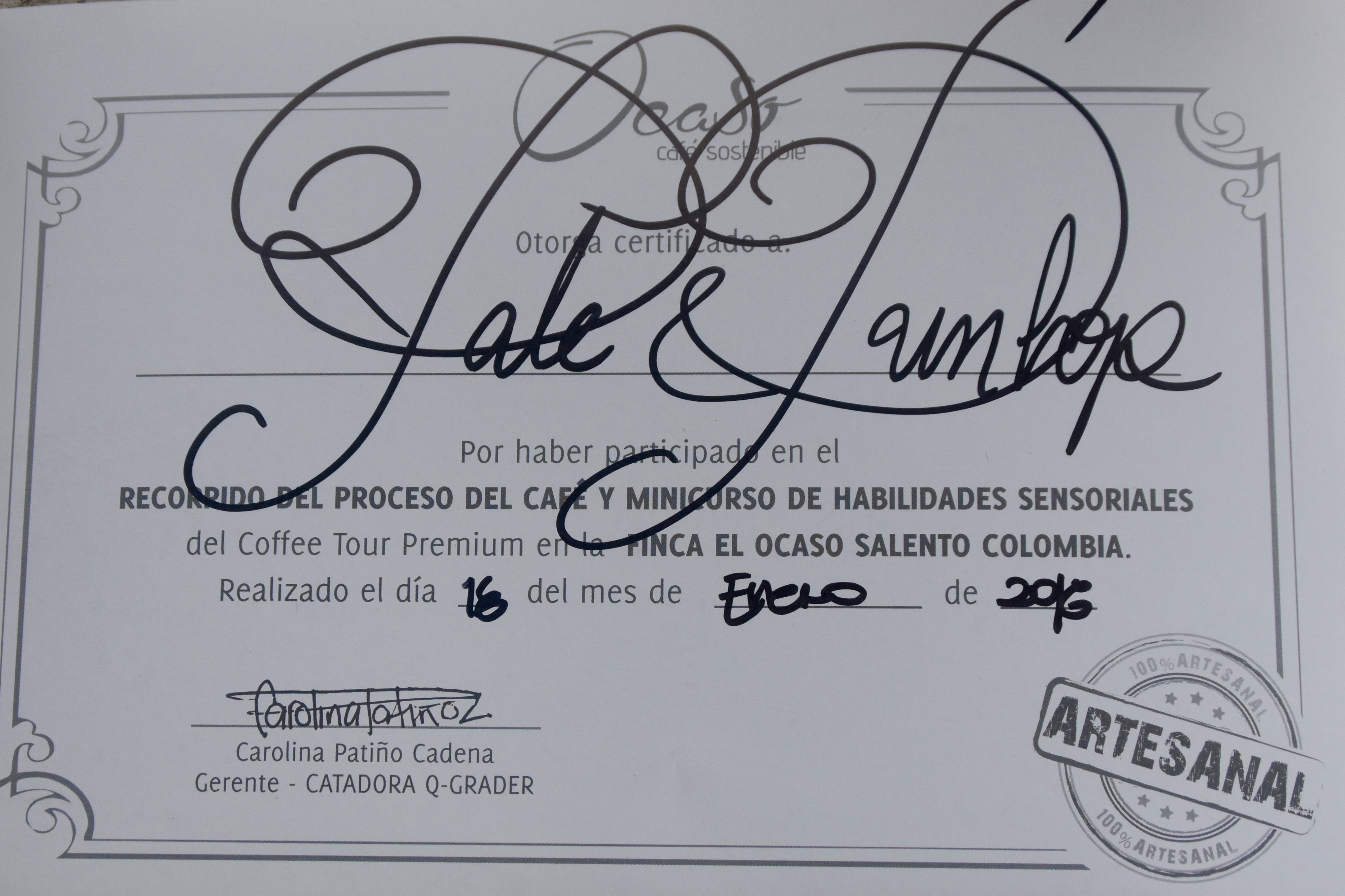
Before leaving, while Alison watches the many birds coming to the feeders at El Ocaso, I purchase enough coffee for ourselves and as gifts for my staff as well, including one package of the honey beans.
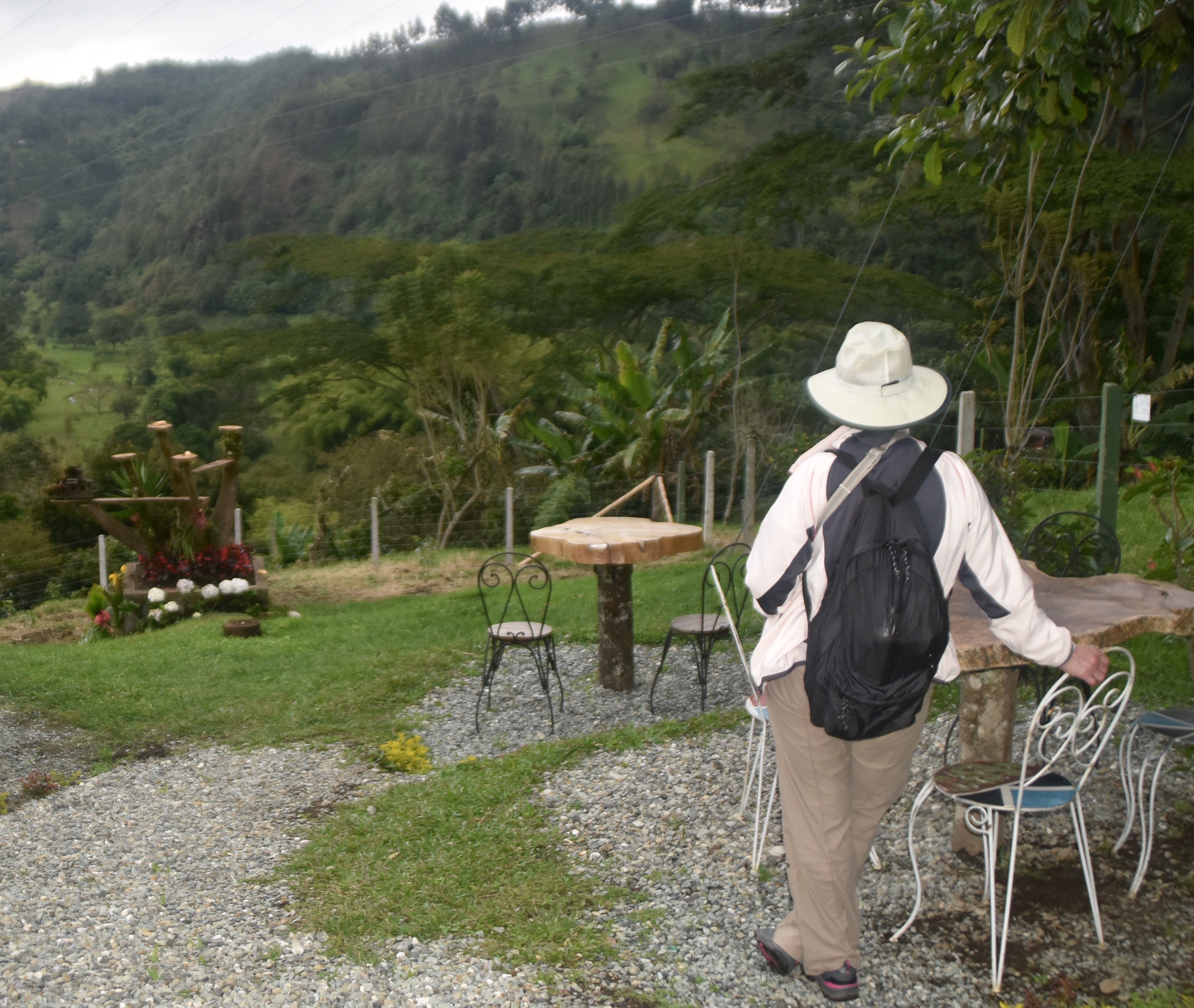
However, I have a confession to make; back in Canada I pull a dog in the manger act and refuse to give up any of the precious Colombian coffee. Instead I present my staff with some very nice hand crafted bowls made by the Embera tribe of Panama, using the excuse that long after the coffee was gone the bowls would still be around. What do you think?
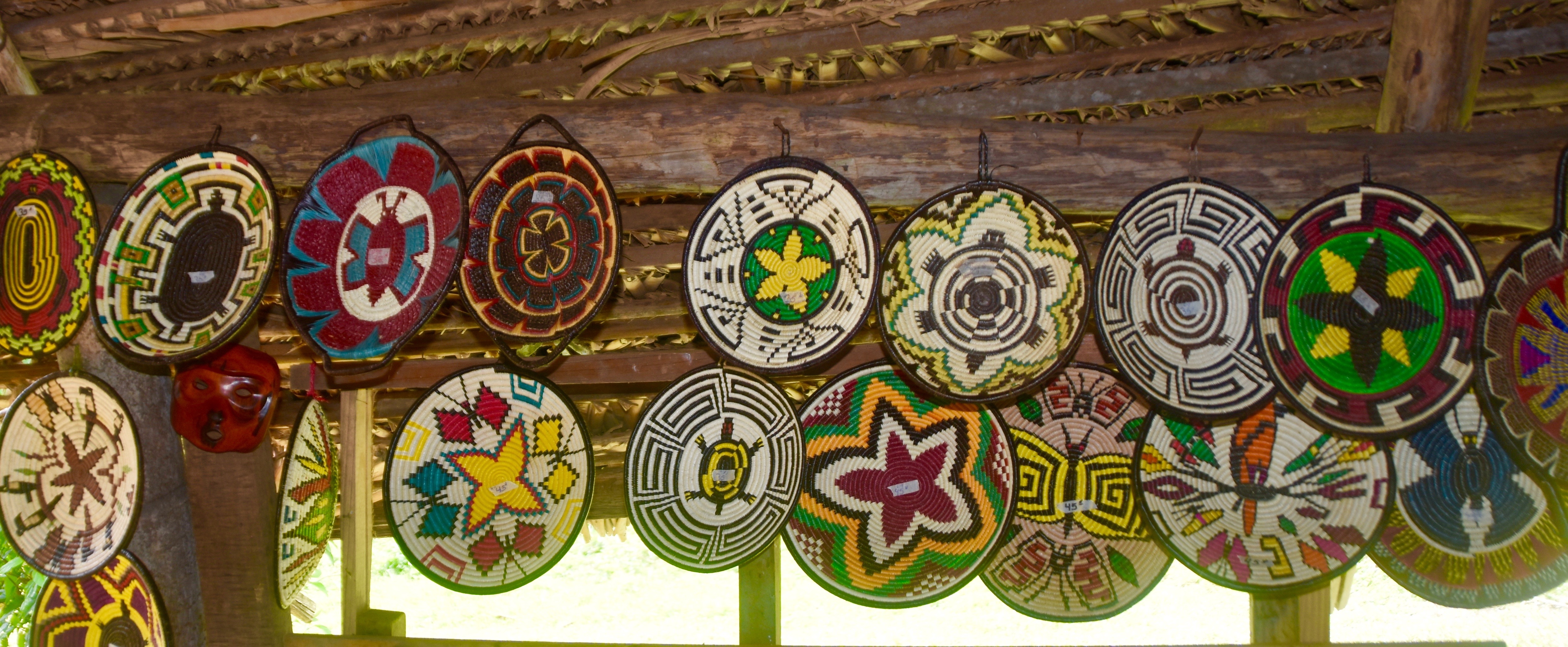
El Ocaso provides three hour tours in English most afternoons of the year. Here is a link to their website if you want details on times and prices.
In conclusion, I’ve learned yet again not to doubt the activities that Adventures Abroad includes on their itineraries. What I sarcastically thought would be an ‘Oh joy’ jaunt, really turned out to be an ‘OH JOY!’ experience. Thank you El Ocaso for finally giving me a great cup of coffee.
Next up, hiking in the beautiful wax palm landscape of the Valle de Cocora. Hope you’ll join us.

